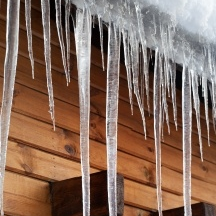 In many parts of the country, during the wintertime, the build up of thick layers of ice along the edges of the roof can cause a number of serious problems. In Washington State, most areas to the east of the Cascade Mountains experience this same event. A number of homeowners utilize low wattage deicing cables to assist in melting this ice buildup thereby providing a pathway for the melted snow water to escape from the roof. However, these systems require frequent monitoring and testing to ensure proper operation.
In many parts of the country, during the wintertime, the build up of thick layers of ice along the edges of the roof can cause a number of serious problems. In Washington State, most areas to the east of the Cascade Mountains experience this same event. A number of homeowners utilize low wattage deicing cables to assist in melting this ice buildup thereby providing a pathway for the melted snow water to escape from the roof. However, these systems require frequent monitoring and testing to ensure proper operation.
Over a short period of time, the accumulation of snow on a roof will incur melting at the warm roof surface over the heated portions of the home. This water slowly travels down-slope to the outside eaves and overhangs. Generally, these overhangs are exposed to cold air underneath and do not benefit from the thermal effects of the upper roof surfaces. As this melted water encounters these relatively cold overhang surfaces, it refreezes. As additional water travels down, it will add successive layers of ice creating an “ice dam”. Instead of shedding water as a roof is designed to do, it is now allowing water to pool up behind this ice dam and then travel back under the shingles. When this water gets back into the wood structure, there is then the potential for water leaks, wet insulation, mold formation and wood rot. Also, any water under the shingles that refreezes can damage, crack and cause premature deterioration of your roof’s protective coverings. Roofs that are either uniformly warm or uniformly cold along the entire surface do not suffer from ice damming.
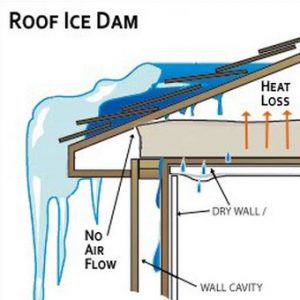 The picture on the right is indicative of an ice damming problem. Icicle formation is often a symptom of ice damming, a serious condition that can ruin the roofing, the sheathing below, the rafters and joists that support the roof, the insulation, the paint on the exterior walls, and even the interior finish of your home. In this picture, you can see the icicle formation as well as the approximately 2 inch thick layer of ice below the snowline.
The picture on the right is indicative of an ice damming problem. Icicle formation is often a symptom of ice damming, a serious condition that can ruin the roofing, the sheathing below, the rafters and joists that support the roof, the insulation, the paint on the exterior walls, and even the interior finish of your home. In this picture, you can see the icicle formation as well as the approximately 2 inch thick layer of ice below the snowline.
 The other concern that arises from this ice damming is the added weight to the roof structure. Each inch of ice thickness will add approximately 5 lbs./square foot of extra load to the roof. I’ve seen some roofs with 4 inches or more of ice on the eave which add another 20 pounds of extra weight. Once you add the weight of any additional snow on top of this ice, you could be easily reaching the maximum design stress limits of the structural components. In some houses, I’ve observed significant cracking and compression of the interior drywall along the outside wall edges from heavy ice damming loading. These are serious signs that indicate the need to take corrective action immediately.
The other concern that arises from this ice damming is the added weight to the roof structure. Each inch of ice thickness will add approximately 5 lbs./square foot of extra load to the roof. I’ve seen some roofs with 4 inches or more of ice on the eave which add another 20 pounds of extra weight. Once you add the weight of any additional snow on top of this ice, you could be easily reaching the maximum design stress limits of the structural components. In some houses, I’ve observed significant cracking and compression of the interior drywall along the outside wall edges from heavy ice damming loading. These are serious signs that indicate the need to take corrective action immediately.
There are a variety of measures that could be implemented to prevent ice damming in the first place. One solution is to create an entire cold roof surface of uniform temperature so there is no thermal melting of the snow above the interior portions of the home. The other solution would be to provide heat to the underside of the eaves. Both of these solutions are not very practical on existing buildings where ice damming is already occurring. Also, heating the overhang area would not be a very efficient method of solving the problem plus it would involve the additional expense of enclosing the overhang.
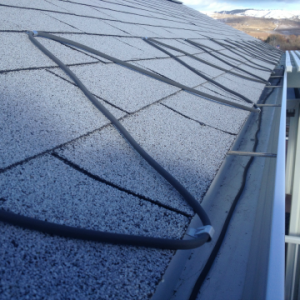 The easiest solution for most existing buildings is to install low wattage deicing cables in the gutters, downspouts and loop these up onto the top of the roof for the depth of the cold overhangs. The cable melts any ice around its perimeter to then allow the unrestricted flow of water from upper portions of the roof to travel off the roof or into the gutters and downspout system. Because these electrical cables are in contact with water, the electrical codes also require these be connected to a GFCI (ground fault circuit interrupter) to protect against electrical shock in the event of a short or malfunction in the cable or other connections completing the circuit. Some homeowners activate their cables at the beginning of the winter season and these operate 24/7 until early spring. Others utilize thermostatically controlled switches or power adapters that activate the cables at certain ambient temperatures and/or moisture conditions. Due to all of the variables and components involved, it is very easy for any component in the system to malfunction thereby rendering the system inoperable with the potential to cause major damage to the home.
The easiest solution for most existing buildings is to install low wattage deicing cables in the gutters, downspouts and loop these up onto the top of the roof for the depth of the cold overhangs. The cable melts any ice around its perimeter to then allow the unrestricted flow of water from upper portions of the roof to travel off the roof or into the gutters and downspout system. Because these electrical cables are in contact with water, the electrical codes also require these be connected to a GFCI (ground fault circuit interrupter) to protect against electrical shock in the event of a short or malfunction in the cable or other connections completing the circuit. Some homeowners activate their cables at the beginning of the winter season and these operate 24/7 until early spring. Others utilize thermostatically controlled switches or power adapters that activate the cables at certain ambient temperatures and/or moisture conditions. Due to all of the variables and components involved, it is very easy for any component in the system to malfunction thereby rendering the system inoperable with the potential to cause major damage to the home.
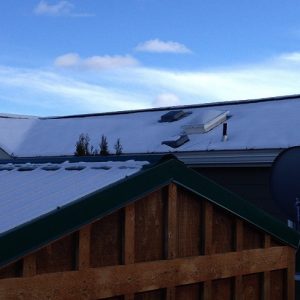 This image shows what can happen when any of the devices supplying power to the deicing cables has failed. This house was activated in late fall prior to the homeowner leaving for the winter. You can see that there is only a few inches of snow on the roof and yet the deicing cables are not even melting this minimal amount of snow. During troubleshooting of this system, it was discovered that the thermostatically controlled switch had failed (a simple $12.00 part). Fortunately, this was caught early before any heavy snow and ice damming had occurred. If left undiscovered for the duration of the winter, this could have resulted in significant and costly damage to this home. On other homes, the GFCI circuits have tripped and shut off power to the cables as well. In some instances the cable has exceeded its average lifespan of 8 to 10 years and simply needs to be replaced. Like everything else in your home, there is a limited lifespan to how long these products will last under normal conditions.
This image shows what can happen when any of the devices supplying power to the deicing cables has failed. This house was activated in late fall prior to the homeowner leaving for the winter. You can see that there is only a few inches of snow on the roof and yet the deicing cables are not even melting this minimal amount of snow. During troubleshooting of this system, it was discovered that the thermostatically controlled switch had failed (a simple $12.00 part). Fortunately, this was caught early before any heavy snow and ice damming had occurred. If left undiscovered for the duration of the winter, this could have resulted in significant and costly damage to this home. On other homes, the GFCI circuits have tripped and shut off power to the cables as well. In some instances the cable has exceeded its average lifespan of 8 to 10 years and simply needs to be replaced. Like everything else in your home, there is a limited lifespan to how long these products will last under normal conditions.
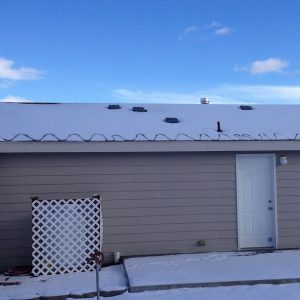 One of the critical steps that every homeowner should undertake is the frequent inspection and monitoring of their roof deicing systems especially during and after winter snowstorms. In late fall, the cable and all components should be checked for proper operation and electrical resistance or insulation resistance tests should be conducted to ensure that cables will be functional when needed. When snow and ice are already on the roof, it is too late to try and install replacement cables. There are some other techniques that can be utilized in the event that a cable should fail and a certified Homewatch professional should be able to recommend and implement those solutions. A qualified Homewatch professional should also be checking the operation of the deicing cables on each inspection visit and troubleshooting when problems arise.
One of the critical steps that every homeowner should undertake is the frequent inspection and monitoring of their roof deicing systems especially during and after winter snowstorms. In late fall, the cable and all components should be checked for proper operation and electrical resistance or insulation resistance tests should be conducted to ensure that cables will be functional when needed. When snow and ice are already on the roof, it is too late to try and install replacement cables. There are some other techniques that can be utilized in the event that a cable should fail and a certified Homewatch professional should be able to recommend and implement those solutions. A qualified Homewatch professional should also be checking the operation of the deicing cables on each inspection visit and troubleshooting when problems arise.
At Lake Chelan HomeWatch , we visually check the operation of roof deicing cables and we also look for telltale signs indicating when the system may not be functioning properly. For our clients, we also check these systems out during late fall to identify if any equipment has failed and needs replacing. We have found that the hot summers and cold winters in our region with the resulting huge temperature swings put these systems under enormous stress and failure. Cable insulation can become brittle and crack when subjected to these extreme temperature changes thereby allowing water to penetrate into the core of the cable causing failure. For more information on how we can assist you, please contact us by clicking here!

Recent Comments